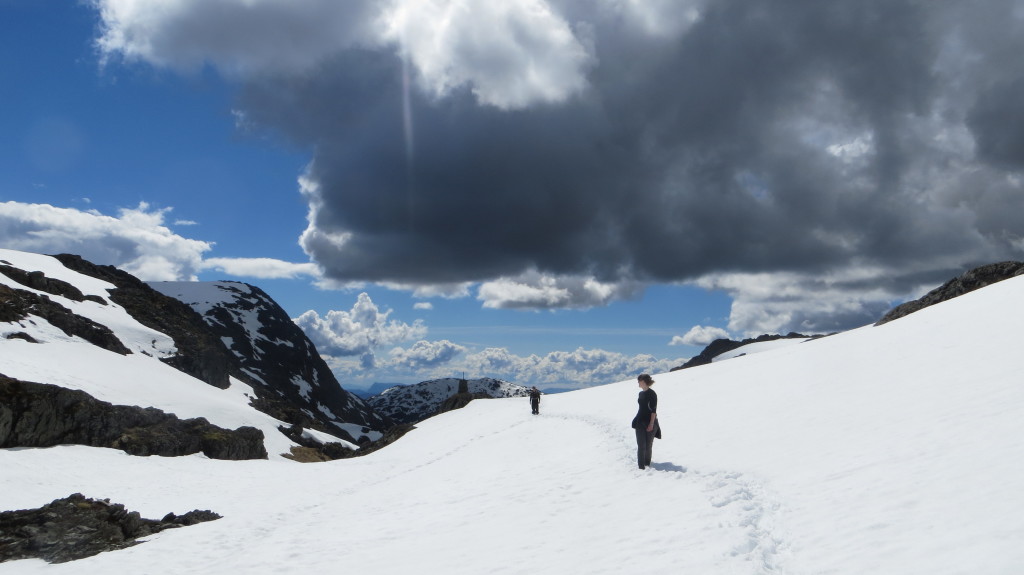Norwegians love their mountains. They go there for hiking in the summer, skiing in the winter, and all year round to enjoy the company of friends and family in remote, cosy cabins. But I wonder, do the Norwegians know why their mountains are there in the first place? If they do, they know more than the scientific community. Here significant controversy surrounds both age and origin of these mountains.
Controversy exists because it is inherently difficult to assess mountain heights back in time. Scientists can easily measure the age of the rocks that make up the mountains. However, the resulting ages will tell us when minerals crystallized to form rocks deep in the Earth, and not how or when the rock surface has moved up or down relative to sea level. A mountain range that formed 10 million years ago can therefore easily consist of rocks that are billions of years old. In most cases of mountain formation, these older rocks are forced upwards when the stiff outer layers of the Earth (known as tectonic plates) collide. Scientists can trace these plates back in time, and assess when collisions and mountain formation took place. However, the Norwegian mountains are located in an area where the plates are currently moving away from each other. In fact, plates last collided in this region more than 400 million years ago. This complicates things, and as a result we have no direct observations to rely on when assessing how and when the Norwegian mountains rose to their current elevation. As a result, several hypotheses for their formation have been proposed.
The classical hypothesis for Norwegian mountain formation assumes that the mountains are young (in geological terms), raised from a flat plain to their current elevation during the last 20 million years or so. The Norwegian geologist Hans Henrik Reusch first proposed this hypothesis more than 100 years ago, in order to explain the flat mountain tops that prevail in many regions of Norway. According to the idea of Reusch, the flat-topped mountains in Norway once formed a coherent plain at sea level. This classical view has been supported by offshore observations, where a recent increase in sediment build-up is assumed to be the result of rapid erosion of the uplifted surface. However, Reusch did not explain how the mountains were uplifted. And although many scientists have since tried, no convincing mechanism for recent km-scale uplift in Norway exists today.
This has sparked a new hypothesis: that the mountains in Norway have prevailed since the last phase of mountain collision more than 400 million years ago. In this new hypothesis, a changing climate, and not surface uplift, varies how the land erodes, and how the offshore sediments accumulate. And by pushing the age of mountain formation back to the most recent phase of mountain collision, we avoid having to introduce a conspicuous uplift mechanism in recent geological times.
So, by introducing a new hypothesis we solve one problem, but are we just replacing one question with another? Although mountains are relatively stable features on human timescales, gravity, wind, water, and ice will break down even the hardest rocks over million of years. This begs the question: how can mountains survive for more than 400 million years?
To answer this, we can think of a mountain as an iceberg, but instead of ice floating in water, we have stiff, light rock floating in a warm sea of dense, deformable rock. If we were to melt the top of an iceberg, buoyancy forces will move the rest of the iceberg upward, so one tenth of the mass is always above sea level. In geology we call this isostasy, and it means that every time you erode one kilometre of mountain, 800 meters will ‘pop up’ again. With the small rates of erosion that we measure on the Earth’s surface today (meters per million years), this isostatic uplift makes it possible for a mountain range to prevail for hundreds of millions of years.
Despite the attractiveness of the isostatic explanation, there is still no common consensus in the research community. Researchers have access to the same data, but they continue to interpret it differently. It is possibly just a matter of time. The classical hypothesis on Norwegian mountain formation has existed for more than 100 years, whereas the new hypothesis was proposed only six years ago. Every time a new hypothesis comes along, scientists have to re-evaluate all previous information. This re-evaluation can be quite controversial as many geological observations are indirect indicators rather than direct evidence. In addition, scientists may have to break with long-standing traditions within their field; traditions they may have built their entire careers around. Finally, information has a tendency to travel slowly between the different scientific fields, delaying the process of adapting to new ideas. So, although six years may seem like a long time in many contexts, little has happened to convince the scientific community of the validity of the new hypothesis. We will probably have to wait longer, in order to see whether the new hypothesis will take over as common knowledge, or whether the classical views will prevail.
One thing is however certain: Norwegians will continue to enjoy their time in the mountains regardless of their age and origin. I only hope that the controversy surrounding the formation of these beautiful mountains will add an extra dimension to the experience next time they go.
[A Norwegian version of this snack appears in the newspaper Aftenposten. Translated by Gudrun Sylte at the Bjerknes Centre for Climate Research]








